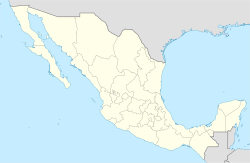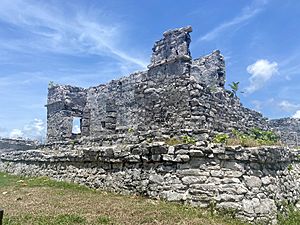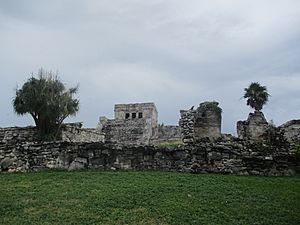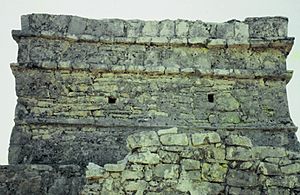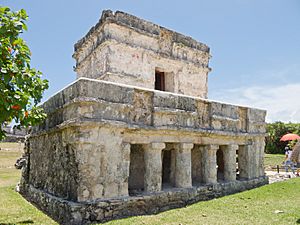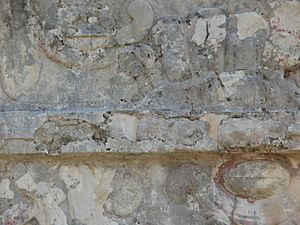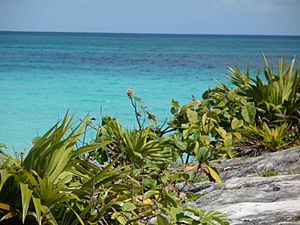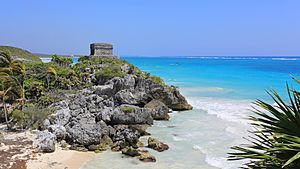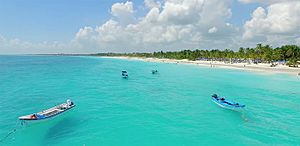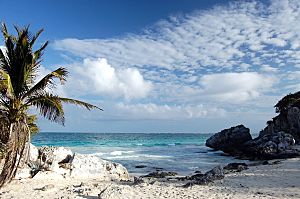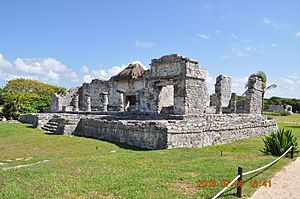Tulum facts for kids
Quick facts for kids
Tulum
Tulu'um
Zamá
|
|
|---|---|
|
Maya site
|
|
| Tulum | |
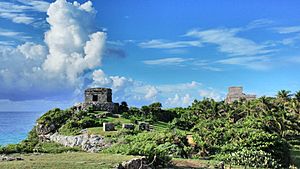
Temple of the God of Wind (left) and Castillo (right)
|
|
| Country | Mexico |
| State | Quintana Roo |
| Municipality | Tulum |
| Earliest inscription | AD 564 |
| Constructed | 1200 and 1450 |
| Elevation | 12 m (39 ft) |
| Time zone | UTC-5 (EST) |
| • Summer (DST) | UTC-5 (Eastern Standard Time) |
| Major Airport | Cancún International Airport |
| IATA Code | CUN |
| ICAO Code | MMUN |
Tulum (Spanish pronunciation: [tuˈlum], Yucatec Maya: Tulu'um) is an amazing ancient Maya city. It was built with strong walls and served as a major port for the city of Coba. You can find its ruins in the Mexican state of Quintana Roo.
The city sits high on 12-meter-tall (39 ft) cliffs. These cliffs overlook the beautiful Caribbean Sea on the east coast of the Yucatán Peninsula. Tulum was one of the last cities the Maya built and lived in. It was most important between the 13th and 15th centuries. Even after the Spanish arrived in Mexico, Maya people lived in Tulum for about 70 more years. But by the end of the 16th century, the city was empty. Today, Tulum is one of the best-preserved Maya sites along the coast. It is a very popular place for tourists to visit.
Contents
History of Tulum: An Ancient Maya City
The Maya might have called this city Zama, which means City of Dawn. This is because it faces the sunrise. Tulum is built on a high cliff looking east towards the Caribbean Sea. The word Tulúm in the Yucatán Mayan language means fence, wall, or trench. The strong walls around the city helped protect Tulum from attacks.
Tulum was a very important place for trade. It had access to both land and sea trade routes. This made it a key hub, especially for trading obsidian. Many carvings and paintings at the site show that Tulum was a special place to worship the Diving or Descending God.
Early Discoveries and Studies
The first Europeans to see Tulum were part of Juan de Grijalva's Spanish expedition in 1518. Juan Díaz, a member of this group, was the first to mention Tulum.
Later, in 1843, John Lloyd Stephens and Frederick Catherwood published the first detailed description of the ruins. They wrote about it in their book Incidents of Travel in Yucatan. When they arrived by sea, they were very impressed by a tall building, likely the great Castillo. They drew accurate maps of the city's walls. Catherwood also made sketches of the Castillo and other buildings. Stephens and Catherwood also found an ancient stone pillar, called a stele. It had a date carved on it: AD 564. Experts believe this stele was probably brought to Tulum from another place and reused.
Archaeological work at Tulum continued for many years. Researchers like Sylvanus Morley and George P. Howe started in 1913. They helped restore the site. The Carnegie Institution also worked there from 1916 to 1922. Other researchers like Samuel Lothrop, Miguel Ángel Fernández, William Sanders, and Arthur G. Miller also studied Tulum.
These studies showed that people lived in Tulum during the late Postclassic period, around AD 1200. The city remained active until the Spanish arrived in the early 16th century. By the end of the 16th century, the site was completely abandoned.
Ancient Discoveries in Tulum Caves
In 2020, an underwater archaeology team found something amazing in a cave near Tulum. Led by Jerónimo Avilés, they discovered the skeleton of a woman. She was about 30 years old when she died, and she lived at least 9,900 years ago! Scientists studied her skull and found it was similar to other ancient skulls found in Tulum caves. They also saw three scars on her skull, showing she had been hit hard.
This skeleton was found 140 meters away from another important site called Chan Hol 2. At first, archaeologists thought it might be the missing Chan Hol 2 skeleton. But after comparing the new bones to old photos, they realized it was a different person.
Researcher Samuel Rennie believes these unique findings suggest that at least two different groups of people lived in Mexico during the time when the Pleistocene (Ice Age) was ending and the Holocene (our current era) was beginning.
Tulum's Amazing Architecture
Tulum's buildings have a special style common to Maya sites on the east coast of the Yucatán Peninsula. These buildings often have a step around their base, sitting on a low platform. Their doorways are usually narrow. If a building is large, columns might be used for support. The walls often widen out near the top, with two sets of decorative moldings. Inside, rooms usually have one or two small windows and an altar at the back. The roofs were either made of beams and rubble or were vaulted (curved). This style is similar to what you can see at Chichen Itza, but on a smaller scale.
Tulum's Protective Wall
Tulum was naturally protected on one side by steep sea cliffs. On the land side, it had a massive wall. This wall was about 3–5 meters (9.8–16.4 ft) high and 8 m (26 ft) thick. The part of the wall parallel to the sea was 400 m (1,300 ft) long. The parts running across the site were a bit shorter, about 170 meters (560 ft) on each side. Building such a huge wall took a lot of effort and time. This shows how important defense was to the Maya when they chose this location.
At the southwest and northwest corners of the wall, there are small structures that were likely watchtowers. This proves how well-defended the city was. The wall has five narrow gateways: two on the north, two on the south, and one on the west. A small natural sinkhole, called a cenote, near the northern wall provided the city with fresh water. This impressive wall makes Tulum one of the most famous fortified Maya sites.
Most Famous Buildings in Tulum
There are three main buildings that visitors love to see at the Tulum archaeological site: El Castillo, the Temple of the Frescoes, and the Temple of the Descending God.
Temple of the Frescoes
The Temple of the Frescoes is one of the most amazing buildings here. It has a lower gallery and a smaller second-story gallery. The Maya used this temple as an observatory to track the movements of the sun. You can see carved figures of the Maya "diving god" or Venus deity on the front of the temple. This "diving god" also appears in the Temple of the Diving God. A stucco figure of the "diving god" is still preserved above the entrance on the western wall, which is how the temple got its name. There's also a mural on the eastern wall, painted in a style from highland Mexico called Mixteca-Puebla. Visitors are not allowed inside anymore to protect it.
Temple of the Descending God
The Temple of the Descending God is a single room with a door facing west. It has a narrow staircase built on top of an older temple that served as its base. In a special spot above the door, there's a sculpture of the "diving god." This figure has wings, a headdress, and holds an object in its hands. You can find this sculpture in many places around Tulum.
El Castillo
Also in the main area is the pyramid known as El Castillo, which is 7.5 m (25 ft) tall. El Castillo was built on top of an older building. The stone beams above the doorways in the upper rooms have carvings of snakes. The construction of El Castillo happened in different stages over time.
A small shrine at the top of El Castillo might have been used as a beacon, like a lighthouse, for canoes coming into the port. This shrine points to a gap in the coral reef right opposite the site. Here, there's a small cove and a beach perfect for trading canoes to land. This special feature of the site might be why the Maya decided to build Tulum exactly here. Tulum later became a very important trading port during the late Postclassic period.
Tulum's Important Trade Routes
Both land and sea trade routes met at Tulum. Many artifacts found in and around the site show that Tulum traded with areas all over Central Mexico and Central America. For example, copper items from the Mexican highlands have been found here. Also, flint tools, pottery, incense burners, and gold objects from all over the Yucatán have been discovered.
Traders brought goods like salt and textiles to Tulum by sea. These goods were then sent inland. Tulum also exported goods like feathers and copper objects that came from inland areas. These goods could be sent by sea to rivers like the Río Motagua and the Río Usumacincta/Pasión system. These rivers allowed seafaring canoes to travel inland, reaching both highland and lowland regions.
The Río Motagua starts in the highlands of Guatemala and flows into the Caribbean Sea. The Río Pasión/Usumacincta river system also begins in the Guatemalan highlands but flows into the Gulf of Mexico. It's possible that one of these seafaring canoes was the first one Christopher Columbus saw off the coast of the Bay Islands of Honduras.
Jade and obsidian seem to have been some of the most valuable goods traded here. The obsidian came from a place called Ixtepeque in northern Guatemala, which is almost 700 kilometers (430 mi) away from Tulum. The long distance, combined with how much obsidian is found at the site, shows that Tulum was a major center for trading this important material.
Visiting Tulum: A Popular Tourist Spot
The Tulum archaeological site is smaller than many other Maya sites nearby. However, it is one of the best-preserved coastal Maya sites. Because it is close to modern tourist areas along the Mexican Caribbean coast, and not far from Cancún and the "Riviera Maya", it has become a very popular Maya tourist destination. Many tour buses bring visitors to the site every day.
The Tulum ruins are the third most-visited archaeological site in Mexico. Only Teotihuacan and Chichen Itza receive more visitors. In 2017, over 2.2 million people visited Tulum.
The area around Tulum also has many beautiful natural sinkholes called cenotes. Some popular ones include Maya Blue, Naharon, Temple of Doom, Grand Cenote, and Zacil-Ha. Tulum also has some of the best beaches in Mexico, like Playa Paraiso and Playa Ruinas.
Today, the Tulum tourist area is divided into six main parts: the archaeological site, the Pueblo (the town), the Zona Hotelera (the hotel zone along the beach), Aldea Zama, La Veleta, and the Sian Ka'an biosphere reserve.
Tourism has a big impact on Tulum. Protecting the environment and the historical sites is very important. There are ongoing efforts to ensure that tourism helps preserve this special place for future generations.
Images for kids
-
Main temple at Tulum, litograph in 1844 by Frederick Catherwood.
See also
 In Spanish: Tulum para niños
In Spanish: Tulum para niños


